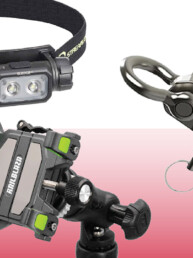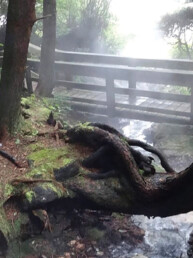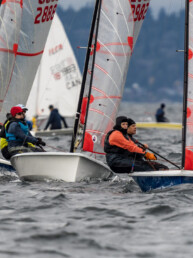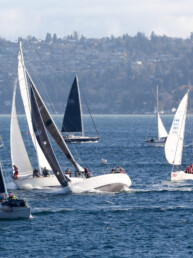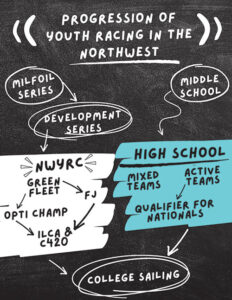 Getting your child into sailing leaves a lot of parents overwhelmed and confused. I can commiserate and understand, there are so many choices! Here in the Pacific Northwest, we have a variety of programs that are trying to meet the varied needs of parents and kids.
Getting your child into sailing leaves a lot of parents overwhelmed and confused. I can commiserate and understand, there are so many choices! Here in the Pacific Northwest, we have a variety of programs that are trying to meet the varied needs of parents and kids.
Recently, I met up with Chris Roberts, an active keelboat racer with a young son who has been getting into sailing, to hear a little about what roadblocks he has faced. Chris has been candid about how puzzling the whole youth sailing scene is to him, and how surprising that is for a parent who is already so deeply involved with sailing. Inspired by our conversation, I worked on some tools that might help prospective parents and grandparents develop more clarity about the various pathways young sailors may explore in our region.
When choosing a sailing program for your sailor, you might start looking at anything from local yacht clubs to community sailing programs, from maritime nonprofits to summer camps. The Sailing Foundation maintains an active list of 50-plus learn-to-sail programs in Washington and Oregon at
www.nwyouthsailing.org. Consider what you are looking for and how important each of those things are. Location and schedule are the obvious ones. However, another good preliminary question to ask the program is what types of boats they will be sailing in that class or camp. Since each program is so different, you will find less frustration if you stay with a program for an extended period. To get a sense of what the program’s goals and opportunities are for each child, I would recommend asking what the sailors in the most advanced classes in their program are doing and if there are multiple pathways offered.
Something that might surprise many parents is that programs typically expect children to take the same class multiple times. Each program writes their curriculum a little differently, so it may be helpful to inquire about the anticipated pace of progress before signing up. Then, if your sailor enjoyed the class or camp, ask the director to give a recommendation about the ideal next steps or camps for your child at the end.
Another frustration parents run into is that available space in many programs fills up quickly, which makes it important to reach out to the program to find out how to get notified when sign-ups open. Space is limited for many reasons. Sailing is a complicated sport that has some inherent dangers, and as a result the ratio of sailors-to-coach is much lower compared to sports like soccer or baseball. Many programs also find staffing to be a challenge because of the amount of knowledge required to teach sailing, not to mention the cost of an effective coach boat.
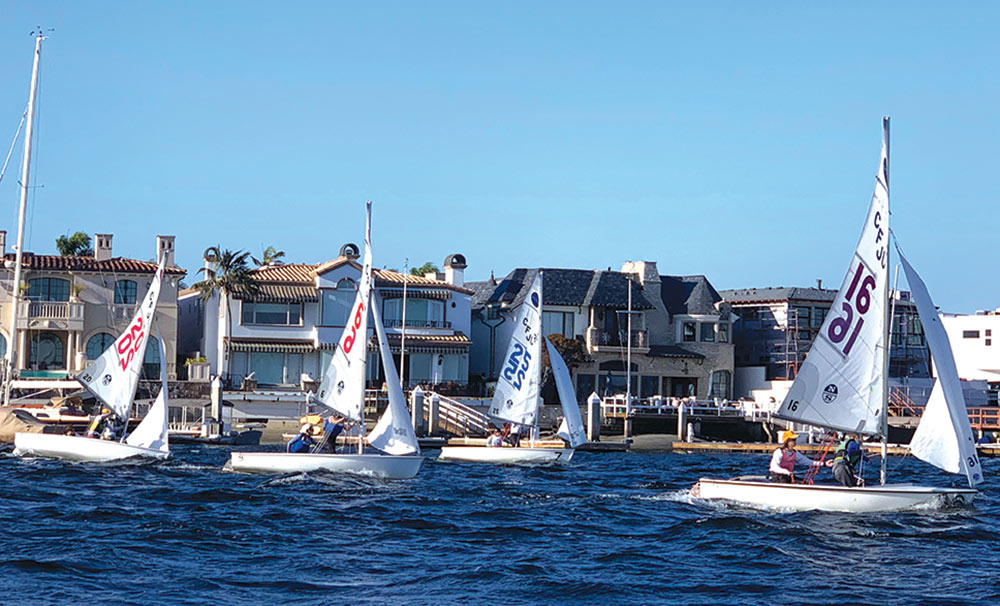
Your Child’s First Day
Most programs give great information about what to expect on the first day, make sure to read it. It is common that parents are asked to leave the premises after drop-off, or may be given an area from which to observe. Many programs these days supply almost everything your child needs for learning to sail; a boat, helmet, lifejacket, and wetsuit. I suggest inquiring what their requirements are for footwear (this is generally not supplied) and whether there are expectations for families to provide additional required or recommended gear. Not all programs require a helmet and wetsuit, so those might not be supplied.
Be prepared that your child will sail very little in the first two days. The time spent on land is crucial to each child’s success and enjoyment of sailing. The skills learned on shore will give the sailor the confidence to enjoy their time on the water—I believe fun comes from the freedom to sail on your own, and freedom comes from a solid foundation of the basic skills. The time spent learning alongside and about their classmates will also help them create friendships that will keep them coming back, even if they are struggling with a skill on the water. Don’t forget to send your child with dry clothes, a towel, water bottle, and sunscreen for reapplying throughout the day.
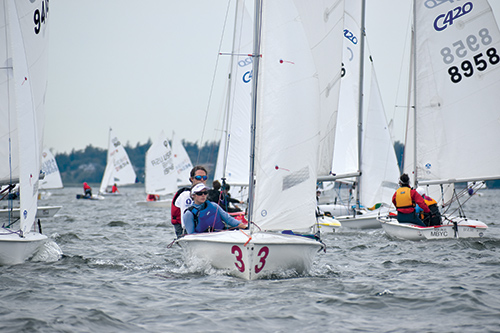
Getting Started in Dinghy Racing
After your child has been sailing for a few weeks, they might be starting to sail independently upwind and might be interested in trying some racing. If you live in the Seattle area, ask your program about the Milfoil Series. This series of fun-focused half-day regattas provides lots of on-the-water support and offers a casual entry to racing. They are normally in very protected areas but, as sailors, we also know that this environment often leads to very challenging conditions—current, along with gusty, shifty, and light winds. If you live outside of Seattle, ask your program director if they host any casual races, and please offer to volunteer.
Dinghy racing is so much fun and joining a race team at most programs requires an invitation from the race coach. If you are interested, ask questions and find out how to get involved. Please do not overlook the question of whether there is space on the team, as well as if your child’s sailing skills are developing enough that they’re ready to join the team. Are they a few years off, are they on the bubble, or are they ready? Remember that, in the interest of safety, it’s possible that your skilled and talented sailor might be considered too young to be relied on to be an active listener and follow instructions, which may delay their invitation.
One step beyond the Milfoil Series, there is a Development Series that offers a couple of regattas in the spring and fall. These are smaller events that often have supplied coaching and allow coaching around the race course. It is a great learning opportunity for newer racers.
Green Fleet Optis at Northwest Youth Racing Circuit (NWYRC) are for sailors at a similar level of progression and skill as the Development Series. The Opti “Green Fleet” is a national concept aimed at introducing young Opti sailors to the world of racing, and its major focus is on learning instead of results. Accordingly, coaching is allowed on the race course (at other levels of racing, a coach is not allowed to communicate with a sailor who is in a race until they have finished the race, unless there is a safety issue). Even in these learning-oriented entry-level racing environments, it’s important to make sure the program director feels that your sailor is ready. This is not a learn-to-sail opportunity, these sailors need to be able to proficiently sail upwind on their own. The coaching is there for tactics, strategy, and rules more than for foundational skills. Once you graduate from this level of sailing there are lots more opportunities, particularly the NWYRC.
The Northwest Youth Racing Circuit is a series of regattas organized by The Sailing Foundation in partnership with hosting clubs and organizations across Washington and Oregon. There are five regattas with classes for Optis, three rig sizes of ILCAs (previously known as Lasers), and C420s. There is a parallel circuit of two regattas for FJ dinghies only that joins the other fleets at Sail Sand Point for a third and final big regatta in the fall.
NWYRC events are two full days on the water, and sailors will be out all day, even eating lunch on the water in between races. It is strongly advised that programs have a coach in a coach boat at these events. This circuit is only getting bigger and stronger as the enthusiasm is very high and the sailing staff around the region becomes more professional. Cameron Hoard, the Seattle Yacht Club Race Coach, tells me that when he moved to Seattle a decade ago, he was the only professional coach on the water, and there were less than half the number of sailors participating. At that time, people who were on the water were mainly safety boats and it was much easier to keep track of all the sailors. Now that there are so many participants, a coach on the water can help ensure their sailors are safe, happy, and learning. Coaches help each other keep everyone safe when a squall comes through or another unpredicted safety concern arises. When the conditions are as expected, the coaches focus on their sailors to make sure they are improving. The Northwest Youth Racing Circuit is the region’s pinnacle event series for young sailors, and is an important stepping stone for developing skills to help sailors on the national stage.

Scholastic Sailing
High school sailing is another popular route to sailing. Many schools take novice sailors who are motivated to be a part of a strong community on the water. Most of these regattas are what we call “A-B rotations”, where four or more sailors make up a team. Two sailors go out and sail two A races in their FJ, then they come to shore and hand off their boat to the second pair on their team who go and race two B races in the same boat. They continue to switch back and forth, and there might be substitutions made. The races are short, around 10-15 minutes long.
Unlike the NWYRC, in high school sailing coaches are not allowed on the water, and any coaching they do happens from shore. These events are organized by Northwest Interscholastic Sailing Association (NWISA), under the national governing body of the Interscholastic Sailing Association (ISSA). There are two types of high school teams, “active” and “mixed” teams. Active teams are those that follow the eligibility requirements of ISSA, where all the sailors are full-time enrolled students at the same high school that is registered with ISSA. Active teams are eligible to compete to qualify for the national championship. Mixed teams are a group of sailors in 8th-12th grade, who might not necessarily go to the same high school. Sailors from mixed teams who want to compete outside of the region in youth sailing should get involved with their local sailing school in another boat like the ILCA 6 and could try to qualify for the ISSA singlehanded national championships, as an individual representing their high school. Check out the NWISA website for more information, especially if you are homeschooling.
The North Sound (San Juan Islands, Bellingham, Anacortes, and Oak Harbor) has started a middle school racing circuit that mirrors many of the principles of high school sailing. They also do A-B rotations, but sail singlehanded RS Tera dinghies. These sailors are getting really good! I can’t wait to see how good their high school teams get over the years.
As you can see, there is so much information to digest. The important thing to remember is that there are options and that, if your child wants to sail, there’s a program to help them do that. It really is an exciting time to be getting involved in youth sailing in the Pacific Northwest!
Solvig Sayre is the Youth Sailing Director at The Sailing Foundation, where she works with programs around the Pacific Northwest. She has extensive experience on the US Sailing Team and leading youth programs around the country. Check www.nwyouthsailing.org.

